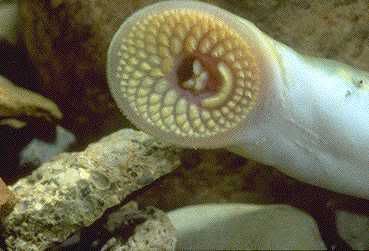 |
| Image from Ohio Department of Natural Resources |
The Ohio lamprey is a 2 foot long, eel-looking fish, which is native to streams and rivers in the eastern Midwest (or western East) states. In their two years as adults they parasitize fish by sucking onto other fish with its gaping maw (also known as an oral disc; lamprey don’t have jaws), where it proceeds to suck the host’s blood1.
Before the parasitic adult stage, baby lamprey (now isn’t that an adorable mental image?) spend four years buried in the riffles of small streams with their head poking out, filter feeding on algae and plankton. After this time, they develop eyes and an oral disc, make their way to a larger river, and find a suitable host. I’m not sure if how frequently they switch hosts, and it’s possible that the scientists don’t know either. After their first year, the lamprey disengage themselves from their hosts, and make their way back to the river that spawned them. Here, they will build a nest, often with the cooperation of other spawning lamprey, lay their eggs in the gravel, and die.
Quick quiz! What have all the aquatic vertebrates I’ve written about had a problem with?
Time’s up! If you guessed “Dams,” you’re correct! With the lamprey, dams stop them from being able to move to their feeding grounds as adults. The entrance of more silt in the streams, usually from runoff, gives the juveniles problems with filter feeding.
There are people working on fixing these problems, through land conservation and habitat monitoring. Determining good solutions for lamprey preservation requires that we learn a lot more about them. Sampling is hard due to their habits of being either buried in a stream or a fish for five-sixths of their life. Getting people interested in them is the first step toward saving them, so I’m trying to do my part.
1Can anybody think of a parasitic vertebrate that isn’t a lamprey? I know of the male anglerfish, but that hardly counts.

7 comments:
Thanks, Garfman! Definitely not among my list of cuddly. (My list includes most of the squamates, like the cuddly blue iguana.)
As for other vertebrate parasites, lampreys (and hagfish, yech!) are ecto-parasites. Another vertebrate ectoparasite would be vampire bats, I think. I'm sure there are other marine examples. If we broaden the forms of parasitism we're willing to consider, cuckoos provide an example of kleptoparasitism, brood parasitism: they "trick" other birds into raising their young.
The Wikipedia article on Parasite notes "Depending on the definition used, as many as half of all animals have at least one parasitic phase in their life cycles."
Good point. Didn't think about vampire bats, nor brood parasitism, which are both good examples.
A marine example is the cookie cutter shark.
The candiru comes to mind. In the limited sense I think you were referring to (that the parasite must be physically attached to the host for an extended period) vampire bats don't really count, especially as they are not exclusively parasitic. With this definition, that is, parasitism akin to what the lamprey does, there are very few parasites which are also vertebrates.
"*Can anybody think of a parasitic vertebrate that isn’t a lamprey?"
Yes...I work with many of them ;-)
Great post!
remember the book about Russian trawler & part where body is caught & autopsy begins & hag fish emerge from incision, worthy of scene from SC's The Thing. Hag fish tie themselves into knots (Yes for real, saw on Nature) & push the knot toward the head forcing the creature into the dead host. Must be dead.
Book included vampire bats research shows adaptation to using chickens. I wonder why wound fails to coagulate until long after feeding, possibly due to feeding on large, very large or cold blooded? Supposed to be vampire the size of human during dino age. One specie desmodus dephyla is modest and shy and smart. Robusta means business. Dephyla can be handled gently says author. J Cousteau says Grandmere prepared eel. Euros eat eel or did. I saw lamprey pair making spawn site and they both vigorously picked up rocks (compare to us lifting volkswagen) with their sucker and carried it a foot, the length of themselves downstream making a rather large rise from the river floor. why downstream? the eggs & spawn would rapidly wash into the dam of loose rock and avoid being eaten by the pupfish that were waiting? Survival strategy---if only trout were so smart.
Gosh! This one looks like one of the most cold blooded killers they show in "Monsters Inside Me" series. Scary!
Post a Comment